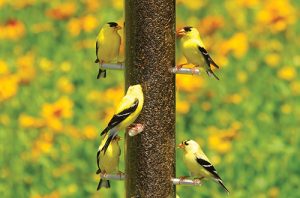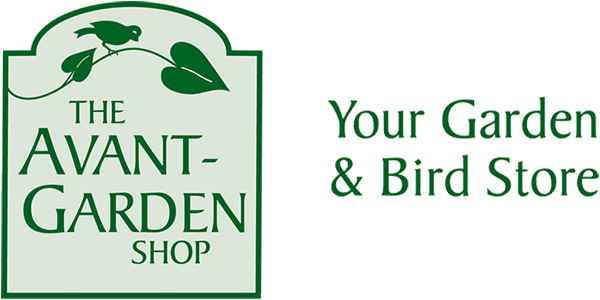American goldfinches (spinus tristis) are cheerful birds and year-round givers.
Even through southern Ontario winters, we’re fortunate to have sufficient food supply to host goldfinches year-round; you’ll often see and hear families and flocks, with their dull green coats and chippery chirps as they bounce in wavy flight from tree to tree to nyger feeder.
They’re fairly easy to identify in flight: they enjoy a wavy, dip-and-up pattern, chattering constantly mid-air with a call described as “per-tee-tee-tee” or “per-chickory”.
A delightful ritual of spring is watching the shift from dull to bright yellow feathers – at some point, they are close to neon, making us squint just to see the beauty beyond the yellow glare.
And in mid-to-late summer, goldfinches remind us to appreciate late bloomers, since the seed pods and thistles of milkweed and echinacea are exactly what they’ve waited for in July and into August – the floss from milkweed to line their nests and the seeds of both to feed their family.
Described as one of the “most vegetarian” birds, goldfinches can survive completely on seeds (though an inadvertently-swallowed insect won’t be rejected).
How to help goldfinches
So now is the time goldfinches are nesting. Having plants like echinacea in the garden provides a natural food for them, but providing offerings from a feeder will always be appreciated by these chipper little birds.
Choose a feeder suited for the small seeds. Product styles range from tubes with perches and ports and perches and sock bags that sometimes come with a domed lid to store extra seed, to a caged feeder that allows only small birds access to seed. To dissuade hungry mammals, consider a dome on top of the feeding tube and a baffle on the pole stem.
Place the feeders in a clear open area – a safe distance from overgrown shrubs that could hide predators like hawks, snakes, and cats – but within a reasonable distance from large trees or a brush pile for safety.
Keep feeders clean, filled and refreshed often. Being an oil seed, niger will dry out after a spell or go rancid in hot weather. If finches aren’t coming to your feeder, it’s a sure sign it’s time to change the seed.
Buy seed from a reputable shop, store in a cool place and remember to clean the feeder often, especially during heat waves.
An interesting seed history
Highly desirable by some of our favourite songbirds (including Indigo Buntings, Pine Siskins, and Common Redpolls) nyger seeds are one of the only bird feed imported from outside North America.
In the 1980s, a contamination scare prompted a sterilization process as part of the seeds’ processing cycle and in the 1990s, it imports were even briefly halted. Scientists continue working hard to manage a safe harvest from American fields but with little success so far.
It’s a special investment to provide quality nyger for these little yellow wonders, but if they give you joy throughout the year, you’ll probably agree that these little guys are worth it. ~
